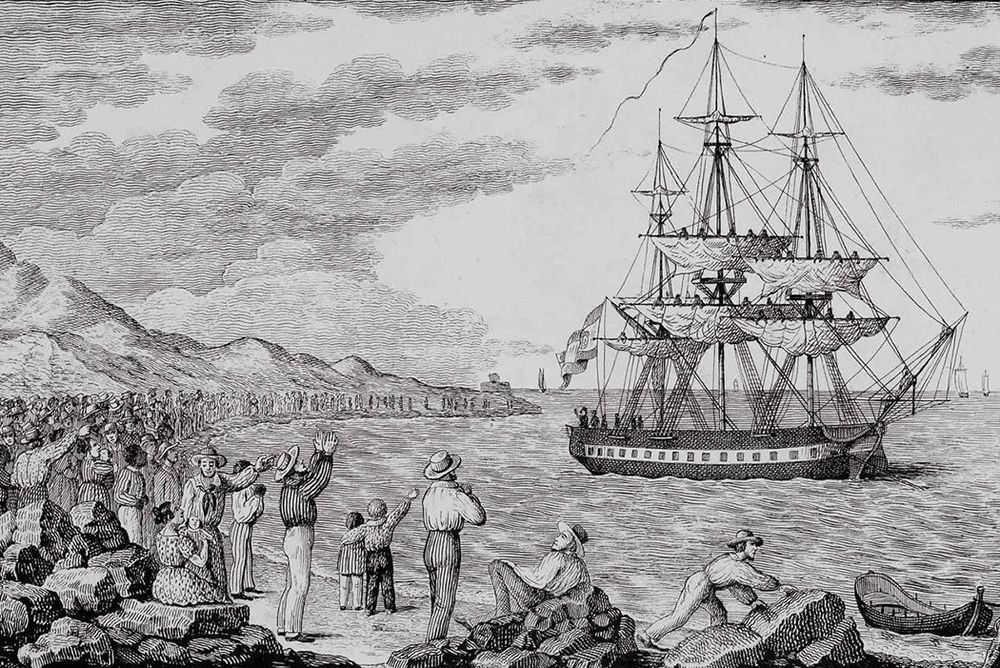The biggest hurdle to mass vaccination in the 19th century was keeping the virus alive out of the human body as the precious pus was being transported in sealed tubes to distant communities ravaging under smallpox. At a time when refrigeration, sterile containment, and asepsis were nonexistent, attempts were made to obtain the vaccine lymph dried onto silk threads or sealed between glass plates, but such methods proved unreliable on lengthy journeys and in warm climates. So when the need arose to vaccinate the remote Spanish colonies in America and Asia, Dr. Joseph Flores, the physician to King Charles IV of Spain, proposed an ingenious solution—carry the virus alive in human subjects.

The corvette María Pita departs from the port of La Coruña in 1803. Engraving by Francisco Pérez.
Before vaccination was invented, the practiced method for inoculation involved taking fluids from pustules of an infected patient and puncturing it into the skin of a healthy individual. The person being inoculated would become infected with smallpox, but the reaction would be less severe and usually not fatal. After about two to four weeks, the patient would make a successful recovery and be immunized. This method was known as variolation and was practiced for centuries in China, India and the Middle East before it was introduced into England and North America in the early 18th century.
At the end of the 18th century in Spain, during the reign of King Charles IV, many members of the Bourbon royal family came down with the disease. The King lost his brother and sister-in-law, as well as his three-year-old daughter Maria Teresa. Another daughter, Queen Maria Luisa, and the Princess of Parma became infected with the virus but survived. Driven by grief and alarm, the King ordered that all unaffected members of the Royal family should be variolated. By 1798, the same year the smallpox vaccine was developed by English physician Edward Jenner, King Charles IV declared that the entire civilian population of Spain should be variolated. Two years later, when a large smallpox epidemic broke out in the Spanish colony of New Granada (now Colombia), the king summoned his physicians and advisers and instructed them to evaluate the means by which vaccination could be introduced to Spain’s remote colonies in America and Asia.

Edward Jenner administers the first smallpox vaccine into James Phipps’s arm in 1796. Photo: University Of Michigan
Dr. Joseph Flores, the King’s court physician, was the one who suggested sending a Spanish corvette to the New World with a large number of children who could act as receptors to the vesicle fluid, passing it from child to child during the long voyage across the ocean, thereby forming a living transmission chain. It may not have been an acceptable or ethical vaccination method by our current hygienic and professional standards, but it was a very creative and effective way of carrying the vaccine within the constraints of the technology at that time.
The Royal Philanthropic Vaccine Expedition, headed by Dr. Francisco Javier de Balmis, set sail from Corunna, Spain, in November 1803, aboard the 160-ton corvette María Pita. The most precious cargo on this ship were twenty-two orphan boys, eighteen of which were donated by a charity hospital and four were selected from a local orphanage. The orphans were aged between 8 and 10, and none had been infected with the smallpox virus nor been previously vaccinated. As the expedition progressed, these young boys were inoculated, one after the other by passing vesicle fluid from one to another. The fluid from the skin vesicles were also kept on glass slides sealed with paraffin and subsequently stored in a vacuum chamber.

The route of the Balmis Expedition from Spain to America.
The Balmis expedition reached Puerto Rico on 9 February 1804, where to his surprise, Dr. Balmis discovered that the Puerto Rican authorities had already obtained the vaccine from the neighboring Danish colony of Saint Thomas. He worked with the governor general to organize a central vaccination board that would record the successful vaccinations performed in Puerto Rico and would keep live serum for future vaccinations. Thereafter, in every place they stopped, the expedition team established vaccination boards.
The expedition then sailed to Venezuela, where they received a jubilant reception. With the collaboration of civil authorities, Balmis was able to conduct mass vaccination of more than 12,000 in less than a month. Balmis also trained local physicians and oversaw the distribution of vaccine in cities and outlying regions, and created the first central vaccination board, on which all others in Spanish America would be modeled.
Due to the enormity of the mission, Balmis decided that the expedition should split into two groups. Dr. Balmis was to led one group to Mexico, Central America, and the Philippines, while Dr. Joseph Salvany was to lead another group to countries in South America.
Balmis and his staff reached Cuba in May 1804, to find that Edward Jenner’s vaccine had beaten them again. Nevertheless, Balmis received a courteous reception, and after reviewing the progress of the vaccination program, Balmis congratulated the Governor on a job well done, and moved on to Mexico. Once more to Balmis’s frustration, he found that the vaccine had arrived in Mexico weeks earlier from Cuba. But the vaccination program was found to be chaotic, which Balmis set in order and quickly sailed on to his next destination, which was Philippines.

The route of the Balmis Expedition in the Philippines.
This time Balmis carried with him 25 orphaned Mexican children as vaccine carriers. The parents entrusted their sons to the expedition for monetary compensation and the promise that they would be returned. The original 22 boys from Spain stayed behind in Mexico. Balmis’s crew vaccinated close to 20,000 people in the Philippines, after which they sailed westbound to Macau and then to Canton (now Guangzhou, China), where he is reported to have widely distributed smallpox vaccination. On the return trip to Spain, Balmis visited the British island of Saint Helena and offered the vaccine to the local population, despite the prevailing political rivalry between Spain and England. He returned to Spain in July 1806.
Salvany’s expedition was comparatively more arduous than Balmis’s, facing punishing terrain and harsh climates of the Andes. Salvany soon began to experience ill health that would accompany him for the remainder of the trip. During their journey in a riverboat up the Magdalena River from the Caribbean coast to Santa Fe, Salvany caught an infection that led to the complete loss of vision in one eye. Eventually, Salvany become ill with pulmonary tuberculosis. Before he died, Salvany broke up his crew into two groups and sent them in different directions. By the time they were finished throughout the South American continent, Salvany had administered hundreds of thousands of vaccines with 200,000 vaccinations in Peru alone. Salvany died in Bolivia in July 1810.

Balmis balcony in the Domus museum in A Coruña, tribute to the people of the expedition. Photo: Nemigo/Wikimedia Commons

Monument in A Coruña in honor of the orphan children who took part of the expedition. Photo: Caronium/Wikimedia Commons
King Charles IV’s vaccination campaign was visionary, taking place almost 150 years before the World Health Organization was established. It was one of the first organized mass vaccination effort in the world, and as a public health campaign it was an extraordinary achievement. Balmis’s crew had to overcome untold obstacles, ranging from the logistics of transport to educating and convincing the local populace. The ball that was rolled by King Charles IV would continue to move for nearly two centuries before the World Health Organization was able to declare that smallpox had been eradicated.
In a paper published in Clinical Infectious Diseases, the authors conclude:
The success of the expedition was due not just to the heroic perseverance and dedication of those who took part in it, but also in their foresight and focus on public education and the use of local molders of public opinion to help get the message across. In this, the expedition is a model of how an expensive, logistically complex international public health effort can translate advanced medical therapy into local cultural contexts.
References:
# Carlos Franco-Paredes, Lorena Lammoglia, José Ignacio Santos-Preciado, The Spanish Royal Philanthropic Expedition to Bring Smallpox Vaccination to the New World and Asia in the 19th Century, Clinical Infectious Diseases
# Catherine Mark 1, José G Rigau-Pérez, The world's first immunization campaign: the Spanish Smallpox Vaccine Expedition, 1803-1813, Bulletin of the History of Medicine



They did a better job than in 2020 and 2021!
ReplyDelete